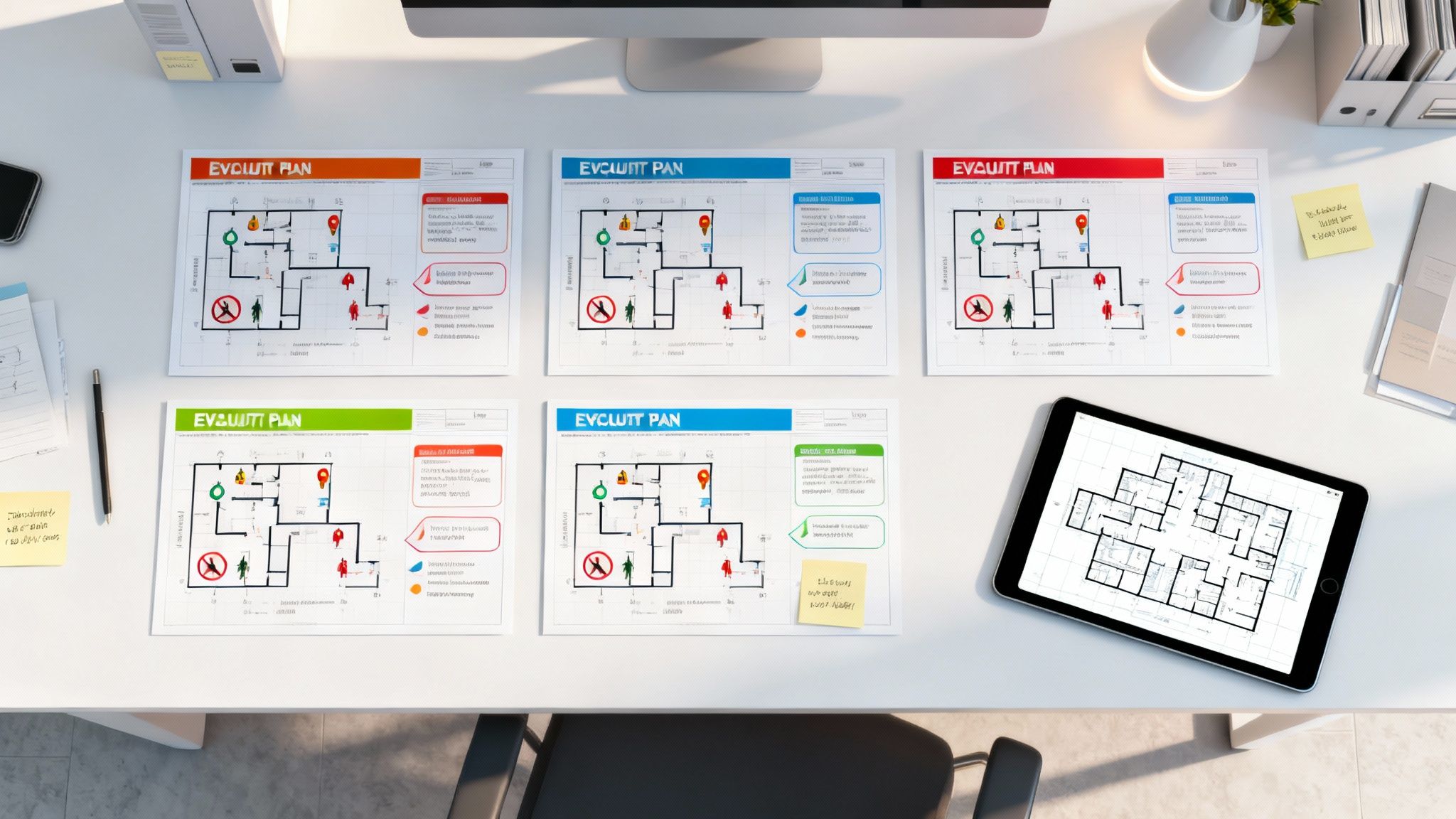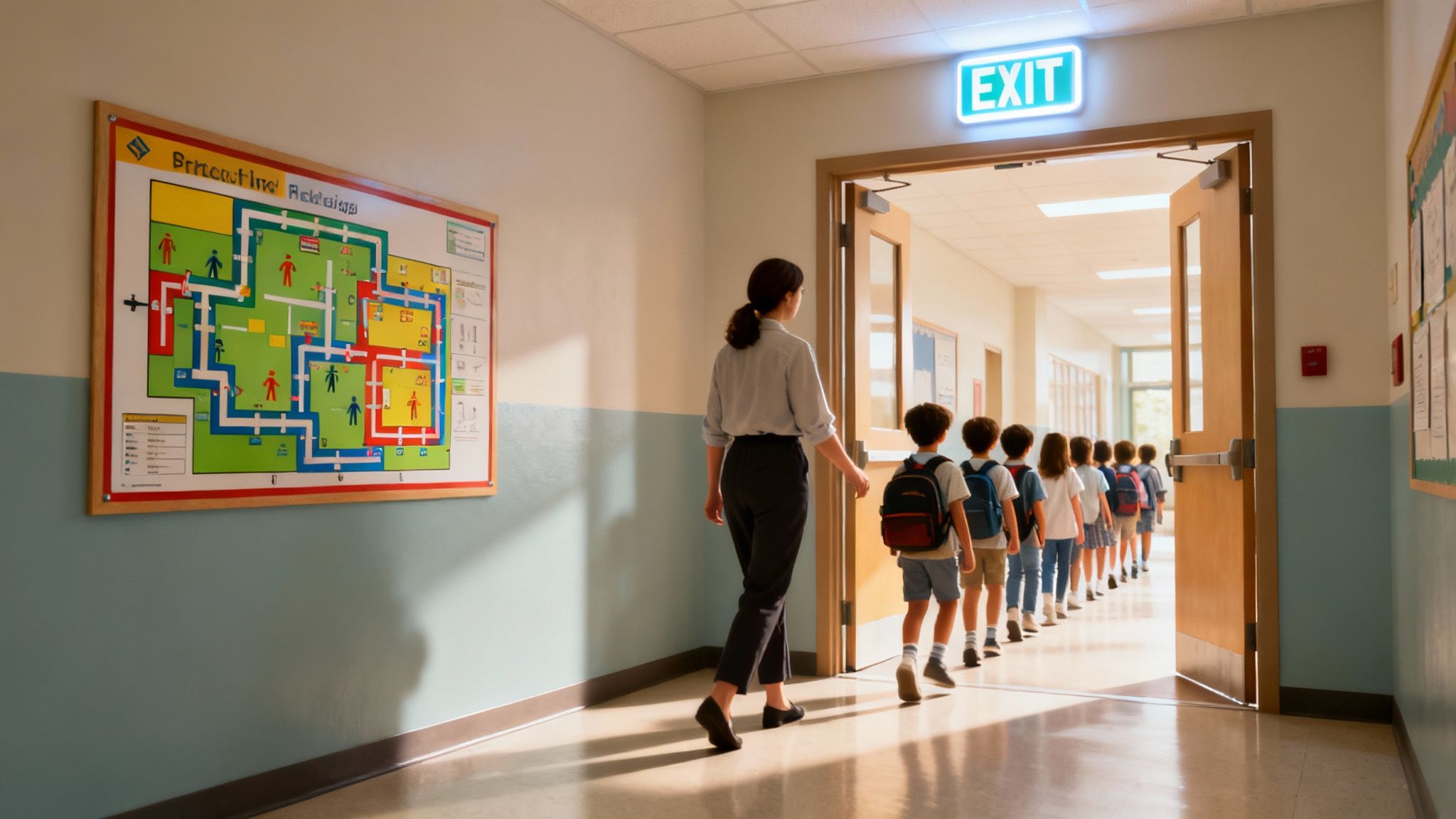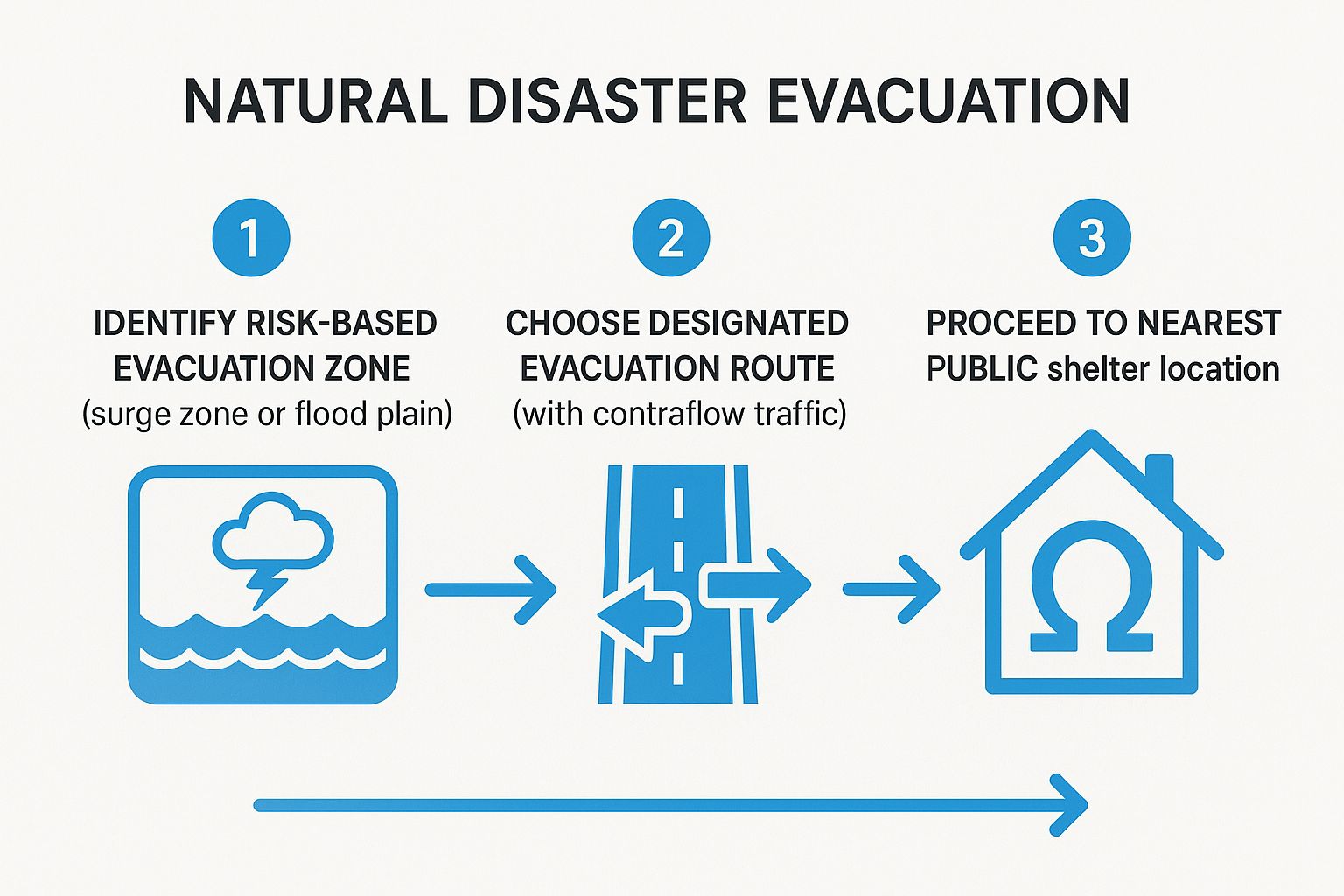
6 Example Evacuation Plan Templates for 2025
In an emergency, seconds count. A well-rehearsed evacuation plan is the difference between controlled safety and life-threatening chaos. In fact, FEMA reports that 40-60% of small businesses never reopen after a major disaster, a failure often stemming from inadequate emergency preparedness. A clear, actionable plan is not just about compliance; it's a vital investment in protecting your most valuable asset—your people. This guide moves beyond theory, breaking down six detailed example evacuation plan templates tailored for diverse environments, from office buildings to industrial plants.
We will analyse precisely what makes these plans effective, highlighting replicable strategies to enhance your own safety protocols. A crucial part of this analysis involves understanding how a modern visitor management system provides total headcount accountability, ensuring no one is left behind. Furthermore, a successful evacuation relies on clear directions. Understanding and implementing the specific regulations for efficient egress is a foundational component of any robust evacuation strategy, emphasizing the importance of clear and compliant Emergency Exit Signage Requirements. Let's explore the practical, life-saving strategies you can implement today.
1. Fire Evacuation Plan for Office Buildings
A fire evacuation plan for an office building is a critical safety protocol designed to guide occupants out of the building swiftly and safely. This comprehensive example evacuation plan isn't just a map on the wall; it's a dynamic system involving clear routes, designated roles, and regular practice. It prioritises a structured response, significantly reducing panic and confusion—a vital benefit in a high-density environment where every second matters.
The core principle is establishing primary and secondary escape routes from every part of the building, ensuring there are always alternative paths if one is blocked by fire or smoke. This strategy is exemplified by the advanced systems in modern high-rises like London's Shard, which incorporate pressurised stairwells and phased evacuation protocols. By having a clear, well-rehearsed plan, you transform a potentially chaotic event into an organised procedure, protecting your people and ensuring business continuity.
Strategic Analysis & Breakdown
The success of a fire evacuation plan hinges on clarity and repetition. A successful 2019 drill in a Chicago office tower, which evacuated over 1,000 employees in under 15 minutes, highlighted the importance of well-trained fire wardens who efficiently cleared each floor. This proves that assigning specific responsibilities is more effective than a general announcement to evacuate. Modern visitor management systems enhance this process by providing an accurate, real-time list of all personnel and visitors on-site, ensuring everyone is accounted for at the designated assembly point. This real-time data is invaluable for emergency services, preventing them from risking lives to search for someone who isn't in the building. A detailed analysis can provide further insights into these procedures; you can discover more about the effectiveness of such plans by reviewing a previous evacuation on visit-us.com.
Actionable Takeaways & Tips
To implement an effective fire evacuation plan, focus on these key actions:
- Conduct Regular Drills: Run drills at least twice a year to build muscle memory and identify weaknesses in your plan.
- Train Fire Wardens: Equip designated fire wardens with the knowledge to conduct floor sweeps and assist those with mobility issues.
- Establish a Buddy System: Pair employees with disabilities or who may need extra help with a designated "buddy" to ensure they evacuate safely.
- Maintain Clear Routes: Regularly inspect and ensure all evacuation paths, including stairwells and corridors, are free from obstructions.
- Use Clear Signage: Install prominent, easy-to-read evacuation maps on every floor and consider using glow-in-the-dark markers for escape routes.
2. School Emergency Evacuation Plan
A school emergency evacuation plan is a highly specialised safety protocol created for educational institutions. This example evacuation plan is designed to manage the organised movement of students and staff during various crises, including fires, gas leaks, and active threats. Unlike a standard workplace plan, it must account for the unique challenges of supervising large groups of children, managing parental communication, and ensuring the safety of students with special needs.

The core of this plan is accountability and control in high-stress situations. It moves beyond simple evacuation routes to include lockdown procedures, reunification protocols, and age-appropriate communication strategies. After the tragedy at Sandy Hook Elementary, a reported 95% of American public schools now conduct active shooter drills. This highlights a shift towards multifaceted approaches popularised by organisations like the "I Love U Guys" Foundation, which standardise responses to different threats. The goal is to create a predictable, rehearsed set of actions that minimise chaos and protect every individual on campus.
Strategic Analysis & Breakdown
The effectiveness of a school evacuation plan lies in its versatility and rigorous practice. The successful evacuation of over 2,000 students during a 2021 gas leak at a Texas high school demonstrated the value of having pre-established off-site assembly points and clear communication channels with emergency services. This incident highlights that a plan's strength is not just in its design but in its real-world application through repeated drills. Knowing exactly who is on school grounds at any moment is a key strategic benefit. Modern digital systems are crucial here, providing instantaneous, accurate rosters of all students, staff, and visitors. This ensures first responders have a reliable headcount, preventing dangerous and unnecessary searches. For more insights on securing educational facilities, explore how a visitor management system for schools strengthens these protocols.
Actionable Takeaways & Tips
To implement a robust school emergency evacuation plan, focus on these critical actions:
- Practise Diverse Drills: Conduct varied drills throughout the year covering fires, lockdowns, and severe weather to prepare for multiple scenarios.
- Establish "Grab-and-Go" Kits: Equip each classroom with an emergency bag containing updated student rosters, first-aid supplies, and essential contact information.
- Use Visual Cues: Implement a system like colour-coded cards for teachers to display on classroom doors, signalling status (e.g., all clear, needs help) to responders during a lockdown or sweep.
- Designate Support Staff: Assign specific staff members to assist students with disabilities or mobility challenges, ensuring no one is left behind.
- Create Off-Site Locations: Establish primary and secondary off-site reunification points for major emergencies that prevent a return to school grounds.
3. Hospital and Healthcare Facility Evacuation Plan
A hospital evacuation plan is an exceptionally complex protocol designed for environments where occupants are medically fragile, immobile, or dependent on life-support equipment. This example evacuation plan must account for staged evacuations, prioritising horizontal movement to safer wings before considering vertical or full-site evacuations. It is a system built on clinical triage, specialised equipment, and intensive coordination to maintain continuity of care under extreme duress.
The core principle is patient safety through phased, controlled movement. This was demonstrated during the 2018 Camp Fire in California, where Feather River Hospital successfully evacuated all 67 patients in under an hour as the fire approached. This required a meticulously organised response, proving that a well-rehearsed plan can function effectively even in the most catastrophic scenarios. Such a plan transforms a potential medical disaster into a managed, albeit challenging, life-saving operation.
Strategic Analysis & Breakdown
The success of a healthcare evacuation is determined by its ability to track and manage patients, staff, and critical equipment simultaneously. The successful evacuation of Houston-area hospitals during Hurricane Harvey highlighted the necessity of pre-established mutual aid agreements with other facilities to accept patient transfers. Unlike a standard office, a hospital cannot simply send people to a muster point; it must ensure every patient is accounted for and their critical care is uninterrupted. The benefit of a modern digital check-in system is that it provides real-time data on every person in the facility, from patients to visiting specialists. This accurate manifest is crucial for emergency services and receiving hospitals, ensuring a seamless transfer of care and accountability.
Actionable Takeaways & Tips
To implement an effective hospital evacuation plan, focus on these key actions:
- Prioritise Horizontal Evacuation: Whenever possible, move patients horizontally to a safer, fire-rated compartment within the same floor to shelter-in-place.
- Conduct Regular Tabletop Exercises: Run scenario-based drills with department heads to stress-test decision-making and communication protocols.
- Stock Evacuation Equipment: Ensure every floor is equipped with evacuation aids like sleds, transfer sheets, and transport-ready wheelchairs.
- Maintain an Accurate Patient Census: Use a reliable system to keep an updated list of all patients, their acuity levels, and specific medical needs for triage purposes.
- Establish Mutual Aid Agreements: Formalise partnerships with nearby healthcare facilities to facilitate patient transfers during a large-scale emergency.
4. High-Rise Residential Building Evacuation Plan
An evacuation plan for a high-rise residential building is a specialised safety protocol that addresses the unique complexities of evacuating a diverse population from a multi-storey structure. Unlike an office, a residential building houses families, the elderly, and individuals with disabilities, making a one-size-fits-all approach inadequate. This example evacuation plan must account for challenges like stairwell capacity and the potential need for defend-in-place strategies.

The core principle involves creating a flexible response that combines full and phased evacuation methods, guided by the building's fire-rated compartmentalisation. The tragic Grenfell Tower fire highlighted the catastrophic failure of a rigid "stay-put" policy when fire containment fails. In contrast, successful evacuations at Dubai's Torch Tower, which experienced multiple fires, demonstrated the life-saving importance of well-rehearsed, adaptable procedures. A robust plan ensures every resident understands when to evacuate and when it's safer to shelter, turning potential chaos into an organised, life-preserving action.
Strategic Analysis & Breakdown
The effectiveness of a residential high-rise plan depends on proactive communication and resident awareness. Post-Grenfell, many London high-rises adopted improved communication systems and clearer guidance, recognising that resident behaviour is a critical factor. A key strategy is maintaining a voluntary registry of residents who may require assistance, allowing emergency responders to act with precision. Integrating a modern visitor management system provides the benefit of tracking guests and contractors, ensuring an accurate headcount during an emergency. This provides first responders with crucial, real-time data, preventing them from conducting dangerous searches for individuals who are not on the premises.
Actionable Takeaways & Tips
To implement an effective high-rise residential evacuation plan, prioritise these key actions:
- Maintain an Assistance Registry: Keep a confidential, up-to-date list of residents who may need help during an evacuation and share it with emergency services.
- Establish a Buddy System: Pair residents who require assistance with neighbours who can help guide them to safety during an emergency.
- Provide Multilingual Information: Ensure all emergency instructions and signage are available in the primary languages spoken by residents.
- Conduct Annual Drills: Run building-wide drills annually to familiarise residents with evacuation routes and assembly points.
- Use Clear Communication: Post evacuation procedures in high-traffic common areas like lifts and lobbies, and distribute them to all residents each year. Never use elevators during a fire.
5. Industrial and Manufacturing Plant Evacuation Plan
An industrial or manufacturing plant evacuation plan is a specialised safety protocol addressing the unique hazards of facilities with heavy machinery, complex layouts, and potentially hazardous materials. This example evacuation plan is more than a simple route map; it's a comprehensive system that integrates procedures for shutting down dangerous processes, accounting for personnel across multiple shifts, and managing potential hazmat incidents. It is designed to mitigate risks unique to industrial environments, such as chemical spills, explosions, and machinery-related accidents.
The core principle is control and containment alongside rapid evacuation. Unlike an office environment, simply leaving is not enough; critical machinery may need a safe shutdown sequence to prevent a catastrophe. The successful evacuation during the 2017 Arkema chemical plant fire in Texas, triggered by Hurricane Harvey, exemplifies this. Although the plant was ultimately lost, the phased shutdown and proactive evacuation of staff and the surrounding community prevented any loss of life, demonstrating the power of a well-executed industrial plan.
Strategic Analysis & Breakdown
The effectiveness of an industrial evacuation plan is measured by its ability to manage complex, simultaneous threats. The investigations by the Chemical Safety Board (CSB) following incidents like the 2013 West Fertilizer Company explosion consistently highlight the need for robust planning that extends beyond the factory fence. This proves that a reactive plan is insufficient; proactive risk assessment and coordination with external agencies are paramount. Modern systems provide the significant benefit of an instant, accurate manifest of all personnel, including contractors and visitors. This ensures that during a chaotic event, accountability is maintained at the assembly point, allowing emergency services to focus their efforts precisely where needed. This level of detail is critical for complex sites, and you can explore more about managing non-permanent staff in our guide on contractor management best practices.
Actionable Takeaways & Tips
To implement an effective industrial and manufacturing plant evacuation plan, focus on these critical actions:
- Implement Process Shutdown Systems: Install easily accessible emergency shutdown controls for critical machinery and processes in multiple, safe locations.
- Use Multi-Sensory Alarms: In high-noise environments, supplement audible alarms with high-visibility strobe lights to ensure alerts are noticed by all personnel.
- Train for Specific Hazards: Conduct regular, hands-on drills that simulate specific risks like chemical spills or equipment failure, not just general fire evacuations.
- Establish Upwind Assembly Points: Designate primary and secondary assembly points that are located upwind from potential chemical release points and use weather monitoring to guide evacuees.
- Maintain Accessible SDS: Keep updated Safety Data Sheets (SDS) for all hazardous materials in a secure but accessible location, such as the emergency assembly point, for first responders.
6. Natural Disaster Evacuation Plan (Hurricane/Flood)
A natural disaster evacuation plan for a hurricane or flood is a massive-scale logistical operation designed to move entire populations out of harm's way. This comprehensive example evacuation plan goes far beyond a single building, coordinating multiple government agencies, transport infrastructure, and public communication channels. It's a pre-emptive strategy to mitigate catastrophic loss of life by establishing clear evacuation zones, routes, and shelter locations.
The core principle is phased and orderly movement, based on risk. The response to Hurricane Irma in 2017, which saw 6.5 million Floridians evacuate, showcased the scale and complexity of such plans. By organising evacuations by zones and implementing contraflow lane reversals on major highways, authorities can manage traffic and prevent the gridlock seen in past events like Hurricane Rita. A well-executed plan transforms a potential city-wide panic into a structured, life-saving migration.
This infographic outlines the fundamental process flow for an individual's response within a broader community evacuation strategy.

Following this clear, sequential process ensures residents understand their immediate risk, the designated path to safety, and where to find official support.
Strategic Analysis & Breakdown
The effectiveness of a regional evacuation plan is measured by its ability to move the maximum number of people to safety with minimal delay and chaos. The stark lessons from Hurricane Katrina in 2005, which exposed critical failures in assisting vulnerable populations, led to significant overhauls. Modern plans now integrate multi-agency coordination, leveraging technology for real-time traffic monitoring and public alerts. Visitor management and emergency response systems offer a key benefit by helping organisations like hospitals and aged care facilities maintain accurate rosters, ensuring every resident, patient, and staff member is accounted for during a chaotic evacuation. This data is vital for emergency services and for a streamlined post-disaster recovery, especially when navigating complex tasks like choosing flood damage services for damaged properties. You can explore a detailed framework in our emergency response plan template on visit-us.com.
Actionable Takeaways & Tips
To prepare for a large-scale natural disaster evacuation, focus on these personal and community actions:
- Know Your Zone: Identify your official evacuation zone and understand its specific risk level for storm surge or flooding.
- Prepare a Go-Bag: Maintain an emergency supply kit with enough food, water, medications, and important documents to last at least 72 hours.
- Plan for Pets: Confirm shelter options for pets in advance, as not all public shelters are equipped to accommodate animals.
- Monitor Official Channels: Rely on information from official sources like state emergency services or the National Hurricane Center, not social media rumours.
- Evacuate Early: Do not wait for mandatory orders if you are in a high-risk zone. Leaving early reduces traffic congestion and ensures you can reach a safe location.
Evacuation Plan Types Comparison
| Evacuation Plan Type | 🔄 Implementation Complexity | 💡 Resource Requirements | 📊 Expected Outcomes | 💡 Ideal Use Cases | ⭐ Key Advantages |
|---|---|---|---|---|---|
| Fire Evacuation Plan for Office Buildings | Moderate: coordination across floors and tenants | Regular training, drills, signage, fire wardens | Systematic evacuation, reduced panic | Multi-story office buildings | Clear roles, scalable, complies with fire codes |
| School Emergency Evacuation Plan | High: multiple emergencies, age-group coordination | Extensive staff training, parent communication | Rapid student accountability, structured response | Schools with diverse age groups | Protects children, includes reunification protocols |
| Hospital and Healthcare Facility Evacuation Plan | Very High: patient care continuity, specialized equipment | Specialized equipment, trained staff, EMS coordination | Safeguarded vulnerable patients, maintained care | Hospitals, nursing homes, healthcare facilities | Prioritizes vulnerable, manages medical logistics |
| High-Rise Residential Building Evacuation Plan | High: phased evacuation, diverse resident needs | Resident education, communication systems | Prevents overcrowding, reduces panic | Apartment buildings, condominiums | Accommodates mobility-impaired, includes pets |
| Industrial and Manufacturing Plant Evacuation Plan | Very High: hazardous materials, equipment shutdown | Technical training, hazmat teams, protective gear | Prevents escalation, handles industrial hazards | Factories, warehouses, industrial facilities | Specialized response, environmental protection |
| Natural Disaster Evacuation Plan (Hurricane/Flood) | Very High: multi-agency coordination, large scale | Government agencies, traffic control, shelters | Saves lives, manages traffic & sheltering | Communities prone to hurricanes, floods | Saves thousands, coordinates vulnerable populations |
From Plan to Practice: Activating a Smarter, Safer Evacuation
Throughout this guide, we have analysed diverse examples of evacuation plans, from the structured drills in a high-rise office to the complex, phased response required in a hospital. Each example evacuation plan underscores a universal truth: a plan is only as effective as its execution. The difference between a chaotic scramble and an organised, safe evacuation lies in preparation, communication, and real-time situational awareness.
A common thread connecting the industrial plant's need to track contractors and the school's duty of care for its students is the critical challenge of accountability. In an emergency, knowing precisely who is on-site and confirming their safety is not just a procedural goal; it is a moral and legal imperative. Relying on outdated paper sign-in sheets or manual headcounts under duress is a significant vulnerability. In fact, post-incident reviews frequently find that minutes lost to uncertainty can lead to tragic outcomes.
Bridging the Gap Between Plan and Reality
The most robust evacuation strategies today are those that integrate modern technology to close this accountability gap. The key takeaways from the plans we’ve examined are not just about designated routes and assembly points, but about creating a dynamic, responsive safety ecosystem.
- Real-Time Data is Non-Negotiable: The benefit of accessing a live, accurate list of every person on your premises—including staff, visitors, and contractors—cannot be overstated. This eliminates guesswork and empowers first responders with the critical intelligence they need to act decisively.
- Communication is Paramount: An effective plan ensures that alerts are sent instantly and that status updates can be managed centrally. This keeps everyone informed, reducing panic and facilitating a more orderly process.
- Drills Reveal Weaknesses: Regular, data-driven drills are essential. By simulating emergencies and using technology to track evacuation times and identify bottlenecks, organisations can continuously refine their example evacuation plan to ensure it is practical and effective.
The True Value of a Modernised Approach
Ultimately, a world-class evacuation plan does more than just tick a compliance box. It demonstrates a profound commitment to the safety and wellbeing of every individual who enters your facility. By moving beyond static, paper-based plans and embracing a smarter, technology-driven approach, you transform your emergency response from a reactive procedure into a proactive, life-saving system. This shift provides not only peace of mind for leadership but also builds a tangible culture of safety that everyone on-site can trust. The investment in a modernised system is an investment in certainty, control, and, most importantly, in people.
Ready to replace outdated paper logs with a dynamic, real-time evacuation management system? Discover how VisitUs provides a live roll call, instant communication, and detailed reporting to ensure your evacuation plan is as safe and effective as possible. Learn more and see how we can help you protect your people at VisitUs.





